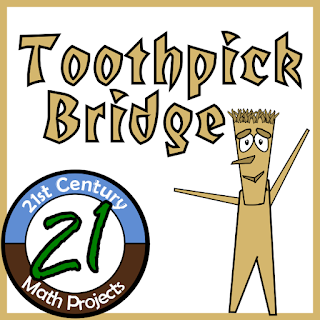For another smooth integration for your science and math curriculum, this 21st Century Math Project intends to bridge that gap. Hahaha get it? Bridge the gap! And it’s a project about Bridges! You get it? Contest style, students will try to build the strongest bridge as light as possible.
Name: Toothpick Bridge
 |
| Take that toothpick out of your mouth and build a bridge with it! |
Suggested Grade Level: 7-12 (Geometry skills)
Math Concepts: Measurement, Shapes, Symmetry
Interdisciplinary Connections: Engineering, Science, Architecture
Teaching Duration: 4-5 Days (can be modified)
Cost: $5 for a 12 Page PDF (1 project, 1 assignment and handouts)
PDF Version: Toothpick Bridge @ TPT
The Product: Students create presentations regarding their design process and the links to geometry. Oh, and of course an awesome contest.
 |
| What’s all that noise?! Student Engagement?!! Bah!! |
One of my favorite high school memories was doing this type of project in Physics. I seemed to have a glue problem — meaning that I used WAY too much glue. I still contend that the bridge didn’t break, but kind of folded. So while I certainly did not invent this project, I thought the applications to geometry were really strong. Each type of design has elements of geometry built in.
 |
| Break stuff? I’m in. |
In this project, teams of up to three students will construct a bridge out of only toothpicks. This toothpick bridge must be able to hold a predetermined load without failing. Teams will research the style of bridges, create a three-view diagram of a bridge, build it, test it and complete a presentation about the project and its connection to geometry and the design process. The ultimate goal is to build a bridge that is strong, but is light as possible. The bridge with the greatest ratio of load weight to bridge weight will win the contest.
I limit students to only using flat toothpicks and Elmer’s glue. I find the simpler, the easier.
As far as testing these bridges go some people like to stack free weights. In high school, I recall this falling on someone’s foot so I didn’t do this. I’ve seen a string connecting a bucket to a 2×4, but that would require having a drill press handy. I’ve chosen to write the project using a good ol’ fashion bungee cord and a large bucket (think a 5 gallon paint can). I like to write these in a way anyone can pull them off with minimal complications.
As far as testing these bridges go some people like to stack free weights. In high school, I recall this falling on someone’s foot so I didn’t do this. I’ve seen a string connecting a bucket to a 2×4, but that would require having a drill press handy. I’ve chosen to write the project using a good ol’ fashion bungee cord and a large bucket (think a 5 gallon paint can). I like to write these in a way anyone can pull them off with minimal complications.
 |
| Who needs a consultation? |
In the bucket, I fill it with water and use a household scale to determine the winner. Of course, you’ll need to borrow a gram scale to measure the weight of the bridge. While it is a little bit of hunting, the payoff promises to be a blast and one that high school students will not forget.
EXTENSION: You could attach a budget to this project! Maybe charging for toothpicks and cups of glue. Maybe charge for an engineering consultation. The possibilities are endless.
It seems around every corner there’s a new STEM school popping up and 21st Century Math Projects can help! If this is interesting I’ve also integrated projects for an Egg Drop, Box Car Derby and Solar Oven.


